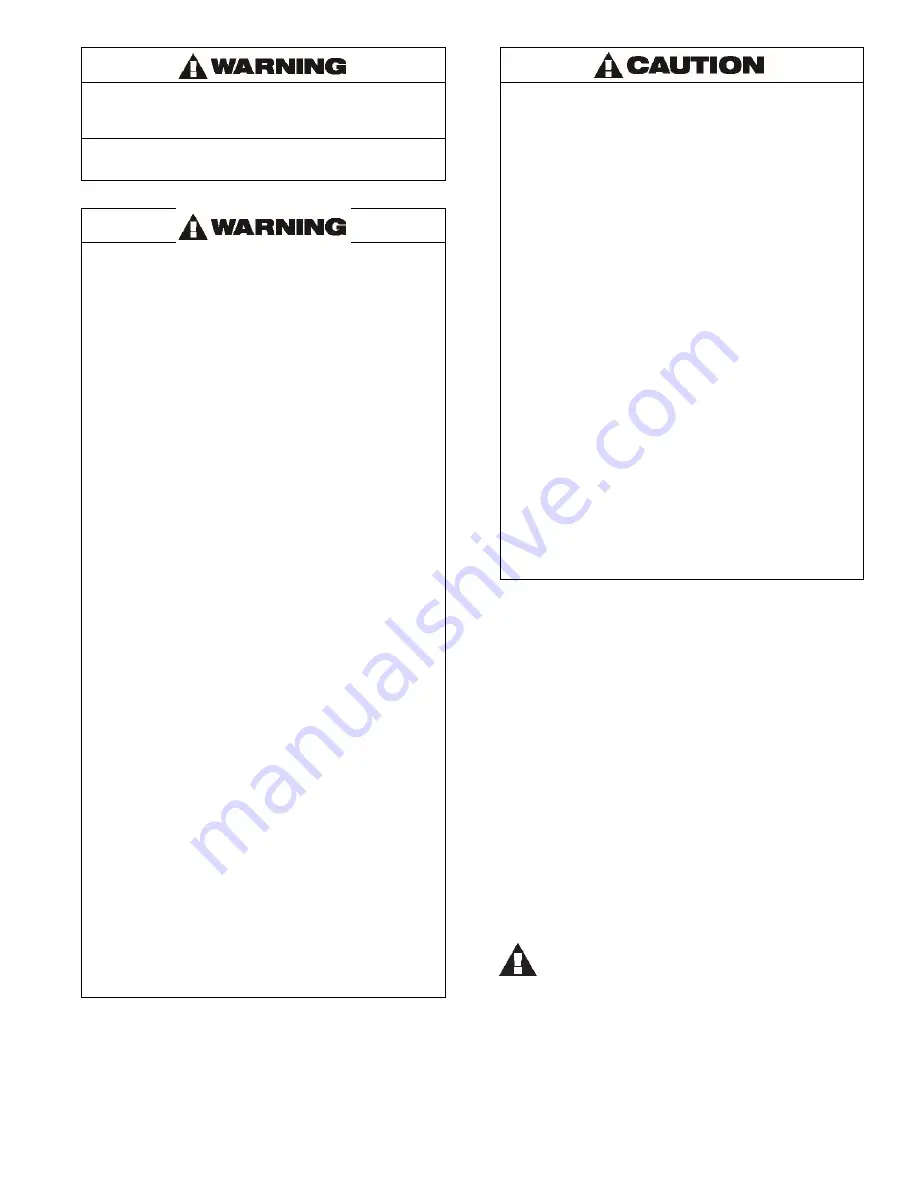
© 2018 Columbus McKinnon Corporation. All Rights Reserved
3
P/N: EL-680 REV AA JULY 2018
Usage of hoists that do not involve lifting of the load on the lower
hook or using hoists in the inverted position without special
precaution may cause an accident resulting in injury and/or
property damage.
TO AVOID INJURY:
Consult Columbus McKinnon for information concerning using
hoists in these applications
Improper operation of a hoist can create a potentially hazardous
situation which, if NOT avoided, could result in death, or serious
injury. To avoid such a potentially hazardous situation, the
operator shall:
1.
NOT operate a damaged, malfunctioning or unusually
performing hoist.
2.
NOT operate the hoist until you have thoroughly read and
understood this Operating, Maintenance and Parts Manual.
3.
NOT operate a hoist which has been modified.
4.
NOT lift more than rated load for the hoist.
5.
NOT use hoist with twisted, kinked, damaged, or worn load
chain.
6.
NOT use the hoist to lift, support, or transport people.
7.
NOT lift loads over people.
8.
NOT operate a hoist unless all persons are and remain
clear of the supported load.
9.
NOT operate unless load is centered under hoist.
10. NOT attempt to lengthen the load chain or repair damaged
load chain.
11. Protect the hoist’s load chain from weld splatter or other
damaging contaminants.
12. NOT operate hoist when it is restricted from forming a
straight line from hook to hook in the direction of loading.
13. NOT use load chain as a sling, or wrap load chain around
load.
14. NOT apply the load to the tip of the hook or to the hook
latch.
15. NOT apply the load unless load chain is properly seated in
the chain wheel(s) or sprocket(s).
16. NOT apply load if bearing prevents equal loading on all
load supporting chains.
17. NOT operate beyond the limits of the load chain travel.
18. NOT leave load supported by the hoist unattended unless
specific precautions have been taken.
19. NOT allow the load chain or hook to be used as an
electrical or welding ground.
20. NOT allow the load chain or hook to be touched by a live
welding electrode.
21. NOT remove or obscure the warnings on the hoist.
22. NOT operate a hoist on which the safety placards or decals
are missing or illegible.
23. NOT operate a hoist unless it has been securely attached
to a suitable support.
24. NOT operate a hoist unless load slings or other approved
single attachments are properly sized and seated in the
hook saddle.
25. Take up slack carefully - make sure load is balanced and
load holding action is secure before continuing.
26. Shut down a hoist that malfunctions or performs unusually
and report such malfunction.
27. Make sure hoist limit switches function properly.
28. Warn personnel of an approaching load.
Improper operation of a hoist can create a potentially hazardous
situation which, if not avoided, could result in minor or moderate
injury. To avoid such a potentially hazardous situation, the
operator shall:
1.
Maintain a firm footing or be otherwise secured when
operating the hoist.
2.
Check brake function by tensioning the hoist prior to
each lift operation.
3.
Use hook latches. Latches are to retain slings, chains,
etc. under slack conditions only.
4.
Make sure the hook latches are closed and not
supporting any parts of the load.
5.
Make sure the load is free to move and will clear all
obstructions.
6.
Avoid swinging the load or hook.
7.
Make sure hook travel is in the same direction as
shown on the controls.
8.
Inspect the hoist regularly, replace damaged or worn
parts, and keep appropriate records of maintenance.
9.
Use the hoist manufacturer’s recommended parts
when repairing the unit.
10. Lubricate load chain per hoist manufacturer’s
recommendations.
11. NOT use the hoist load limiting or warning device to
measure load.
12. NOT use limit switches as routine operating stops
unless allowed by manufacturer. They are emergency
devices only.
13. NOT allow your attention to be diverted from operating
the hoist.
14. NOT allow the hoist to be subjected to sharp contact
with other hoists, structures, or objects through misuse.
15. NOT adjust or repair the hoist unless qualified to
perform such adjustments or repairs.
SAFETY PRECAUTIONS
Each Chester Electric Hoist is built in accordance with the
specifications contained herein and at the time of manufacture
complied with our interpretation of applicable sections of the
*American Society of Mechanical Engineers Code B30.16
“Overhead Hoists,” the National Electrical Code (ANSI/NFPA 70)
and the Occupational Safety and Health Act. Since OSHA states
the National Electrical Code applies to all electric hoists, installers
are required to provide current overload protection and grounding
[on the branch circuit section] in keeping with the code. Check
each installation for compliance with the application, operation
and maintenance sections of these articles.
The safety laws for elevators, lifting of people and for dumbwaiters
specify construction details that are not incorporated into the
hoists. For such applications, refer to the requirements of
applicable state and local codes, and the American National
Safety Code for elevators, dumbwaiters, escalators and moving
walks (ASME A17.1). Columbus McKinnon Corporation cannot be
responsible for applications other than those for which CM
equipment is intended. *Copies of this standard can be obtained
from ASME Order Department, 22 Law Drive, Box 2300, Fairfield,
NJ 07007-2300, U.S.A.
THIS SYMBOL POINTS OUT IMPORTANT SAFETY
INSTRUCTIONS WHICH IF NOT FOLLOWED COULD
ENDANGER THE PERSONAL SAFETY AND/OR
PROPERTY OF YOURSELF AND OTHERS. READ AND
FOLLOW ALL INSTRUCTIONS IN THIS MANUAL AND
ANY PROVIDED WITH THE EQUIPMENT BEFORE
ATTEMPTING TO OPERATE YOUR CHESTER HOIST.























